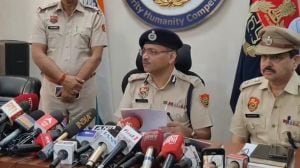Caste census: Rahul claims ‘made Modi govt implement our vision’. Will it cut ice as BJP raises heat?
For two years, Rahul Gandhi has made caste census the centrepiece of his social justice agenda. Govt announcement to hold the same comes with pointed attacks at the Congress.
 For two years, Rahul Gandhi has made caste census the centrepiece of his social justice agenda. (Facebook/Rahul Gandhi)
For two years, Rahul Gandhi has made caste census the centrepiece of his social justice agenda. (Facebook/Rahul Gandhi) The BJP government’s surprise announcement to include caste enumeration in the overdue Census exercise is both good news and bad news for the main opposition Congress and particularly Rahul Gandhi, who has led the demand for it for the past two years.
The demand for a caste census has also been the centerpiece of the Congress’s social justice agenda to reach out to the OBCs, who have moved away from the party in the post-Mandal period and embraced the BJP since 2014 under Narendra Modi.
The apprehension within Congress ranks is that, in one stroke, Modi may have taken away one of its crucial planks. In fact, while announcing its decision on Wednesday to hold a caste census, the government slammed opposition parties for using it as a “political tool”. Union Minister Ashwini Vaishnaw said that while Census comes under the purview of the Centre, some states had done caste enumeration in the name of surveys “non-transparently” (a swipe at Congress-ruled Karnataka and Telangana, apart from Bihar).
He added that it was under Congress governments that caste had not been included in Census operations conducted since Independence.
The Congress is hoping to counter this by claiming the government’s announcement as a vindication of its demand. Addressing a press conference Wednesday evening, Gandhi said the Modi government, which had been “opposed to a caste census”, has now adopted “our vision”. “We welcome it… We have shown that we can pressure the BJP into doing a caste census. We are going to pressure the BJP into removing the 50% cap (on reservations),” he said, adding that a caste census was “the first step” towards “a new development paradigm”.
Gandhi said: “For some reason, we don’t understand what that reason is, they have suddenly decided to do it… after 11 years… Narendra Modi who used to say there are only four castes… he has announced a caste census… We support it completely, but we want to know the timeline… by when it will be done.”
The Census itself was delayed, he said. “There should be allocation of funds. And the developmental vision (based on the caste census data) should be presented before us.”
Gandhi gave the example of the Telangana caste survey as one that could be “emulated” by the Centre. “That could be the blueprint… design is very important. Because there are two examples – Bihar and Telangana. They are completely different,” he said, describing the Telangana survey as “detailed and granular” and undertaken through an “open process”.
While Karnataka, also ruled by the Congress, has done a caste survey too, it was commissioned back in 2015 and is yet to be implemented.
Defining the development paradigm the Congress is seeking, he said: “Not just reservations, but our central question is, be it OBCs, Dalits or tribals, what is their participation, in institutions, power structure… We had something else too, and it was in our manifesto, Article 15 (5), which is reservation in private educational institutions.”
Gandhi’s stress on breaching the 50% reservation ceiling and implementation of Article 15(5) was a message by the Congress leader that the caste census debate had not ended with the Modi government’s announcement, though the momentum on it may have moved to the BJP.
Gandhi hoped that the government would fulfill its promise. “My suspicion is that the strategy is the same as the women’s reservation Bill (which is also tied to the Census). But I hope better sense prevails.”
It was in April 2023 that Gandhi first raised the slogan of “jitni aabadi, utna haq” or proportional representation, ahead of the Karnataka Assembly elections. As the BJP hit back saying this meant that those with lower numbers would lose out under the Congress, the Congress Working Committee meeting later that year was more moderate in its stance.
But Gandhi stuck to his guns and in April last year, during the Lok Sabha election campaign, he said: “Don’t think caste census is just caste survey… we will add economic and institutional surveys. The country will get to know… ki iss jaat main itne log hain, Dalit itne, Adivasi itne, gareeb, general caste itne… Unki aamdani itni hai aur Hindustan ke sansthaon mein inki itni bhagidari hai (that there are these many people in this caste, so many Dalits, Adivasis, poor and the upper castes. That this is their income and this is their share in the institutions of the country).”
The Congress leader said: “We will find out who holds the country’s wealth, what class of people. Aur is aitihasik kadam ke baad hum krantikari kaam shuru karenge… Jo aapka haq banta jai, woh hum aapke liye aapko dene ka kaam karenge (And after this historic step, we will take revolutionary measures… What is your right, we will ensure we get it for you).”
PM Modi countered this saying the Congress was planning to “redistribute wealth”, and made his mangalsutra jibe. “The Shehzada of the Congress has promised ‘X-ray’ of people’s wealth, meaning what is in the locker, the land, gold, silver, mangalsutra, etc., of the people. Woh kehte hain ki aapke paas jo hai, aapse lekar ke jiske paas nahin hai usko de diya jaayega. Matlab jo vote jihad karega, unko diya jaayega (So what they say is that what you have will be taken away from you and given to those who don’t have it. This means it will be given to those who wage vote jihad),” Modi said.
PM Modi also said that the four biggest castes for him were the poor, youth, women, and farmers, and that only uplifting them would lead to the progress of the country.
with inputs from Asad Rehman



- 01
- 02
- 03
- 04
- 05




























